Ling Ling strokes. When the soil is returned to the soil, the top of the hill can be ploughed, which can loosen the soil, protect the earthworms, increase the temperature, and eliminate weeds, thus enhancing the ability of the seedlings to withstand the cold. After 7-10 days of general ploughing, the average temperature in the 5 cm soil layer can be increased by 0.5°C-1°C in the daytime, which is beneficial to the promotion of root development and nutrient transformation. Therefore, regardless of weak seedlings, strong seedlings, or strong seedlings, they must pay close attention to cropping during the return period. For those wheat fields with prosperous tendencies, they can also be properly squatted to suppress spring wheat production. When ploughing, it is necessary to pay attention to mastery of shallowness and fineness, and push the edge of rubbish on the edge.
Repression in time. In the early spring, when the wheat fields are repressed, they can be crushed and the cracks can be bridged to make the wheat roots closely contact with the soil to prevent cold air from invading and damaging the wheat seedlings. At the same time, repression also has a lifting effect, which can increase the water content of the soil surface, which is conducive to alleviating cold and cold damage.
Because of seedlings and fertilizers. The early spring fertilization of wheat can make up for the winter soil consumption, increase nutrient accumulation, promote the growth of wheat seedlings, and resist or reduce the early spring freezing injury. 1 Early fertilizer. Promote weaker and stronger. The main stem and part of the Oita kuri are frozen and should be top-dressed early, with the temperature rising after the beginning of spring, depending on the fertilization of different wheat fields before the application of urea 7-10 kilograms per mu, to promote the birth of young children sooner or later. For late sowing, insufficient basal fertilizer and weak growing fields, we must also apply green manure early, promote rooting, and promote weak growth. 2 supplement fertilization materials, promote frozen leaves as soon as possible to restore vitality. For the freezing damage of wheat leaves, it is necessary to apply 5 kg of urea per mu after returning to the beginning of the green period, so as to promote the normal growth of the wheat seedlings as soon as possible. For the lack of wheat fields to be applied to the water, after the application of shallow loose soil, fertilizer and water mixing. 3 heavy fertilizer application to ensure the steady growth of wheat. For the strong and growing medium- and high-yield wheat fields, it can be seen in the joints before the jointing to the booting, and the application of urea 10-12 kg per mu.
Chemical regulation. In the period of wheat returning to greenery, spraying 30 to 40 kg of 15% paclobutrazol solution at a concentration of 20010-6 per mu can prevent the growth of wheat seedlings and effectively improve the cold resistance of the wheat seedlings.
Do not cut "dead". In the case of a wheat field that is subject to freezing damage by severe cold waves, the frozen leaves cannot be torn off or cut, otherwise mechanical damage will occur and the production will be heavier. After the wheat is frozen, the roots of the alfalfa frozen for a certain period of time can continue to absorb nutrients; at the same time, between the frozen “dead†and the “living†alfalfa, the nutrients can be transferred to each Other , and the “dead†to the living turtle. More than transferred. Therefore, after wheat is frozen, the yield of stems and leaves is higher than that of stems and leaves.
Freeze box damage. “Cream frost damage†has occurred in Shandong Province from the end of March to the beginning of April each year, affecting normal wheat growth. All localities must pay close attention to weather forecasting and do a good job of preventing spring frost damage in wheat, especially for those that have suffered serious frost damage. Small deliveries need to be protected. Preventive measures: Conditional irrigation should be conducted before the cold weather. Remedial measures: In the event of cold currents, timely inspection of seedlings should be carried out to find that the leaves are severely dry and dry, and the heart and leaf and young ears are immersed in water. The timely application of nitrogen, such as urea, can promote the rapid growth of new births.
Seed Cleaner & Grader becomes basic and popular grain seed cleaning equipment in recent years. It helps farmers effectively clean grain harvested from ground. Seed cleaner & grader is used to remove oversize impurity, undersize impurity, light impurity from grain seed. Besides this, it also can grade cleaned seeds to different size ranks. From sesame, wheat, paddy, to soybean, kidney bean, groundnut, Seed Cleaner Cum Grader has wide application.
We have different Grain Cleaning Machine models. Capacity ranges from 3 ton per hour to 20 ton per hour. Each model has its particular feature. We will suggest client suitable model for particular seeds. Grain seed cleaner driving power is 3 phase electricity. We can customize grain cleaner base on different electricity specification for clients worldwide.
Grain cleaner has reliable running, convenient screen replacing and maintenance.
Seed
cleaning machine working procedure: Raw material is
fed from the Bucket Elevator, then elevator transfer raw material to the wind
sieve (air screen). In wind sieve, the straw, smashed pieces, dust and other
light impurity is sucked out by air blower. After air cleaning, raw material is
delivered to sieving trunk. Sieving trunk has several sieve layers. From top to
bottom layer, the sieves holes are from big to small. There are vibration
motors on both sides of the sieve trunk. While grain cleaning machine started, the sieving trunk begin vibration
sifter. Seeds falling on first layer then go through several sieve layers.
First layer sieve will remove the big impurity, final sieve layer sieve will
remove the small impurity. Middle layers can be used to remove either big,
small impurity or grading the cleaned seeds by size difference. Different layer
material has different outlets. Finally clients get cleaned and graded grain
seeds.
Model
Capacity (T/H)
Power (KW)
Weight (KG)
Feature
5XZC-3A
3
7.43
1300
Installed maize thresher
5XZC-3B
3
4.25
1200
5XZC-3C
3
7.25
1300
Installed wheat huller
5XZC-5A
5
12.74
1600
Installed maize thresher
5XZC-5CDH
5
11.74
1700
Installed wheat huller
5XZC-5DH
5
7.74
1600
With cyclone
5XZF-7.5F
7.5
10.1
1800
Double air cleaning systems,
with destoner plate
5XZC-15
10
10.5
1800
With cyclone
5XZC-15A
10
20.93
2200
Installed maize thresher
5XZC-25
20
19.45
2900
Double cyclones
5XZD-15AC
20
20.9
3000
Double sieve trunks


Seed Cleaner Cum Grader,Seed Cleaner Grader,Soybean Seed Cleaner,Air Screen Cleaner
SHIJIAZHUANG SYNMEC INTERNATIONAL TRADING LIMITED , http://www.seedgraincleaner.com